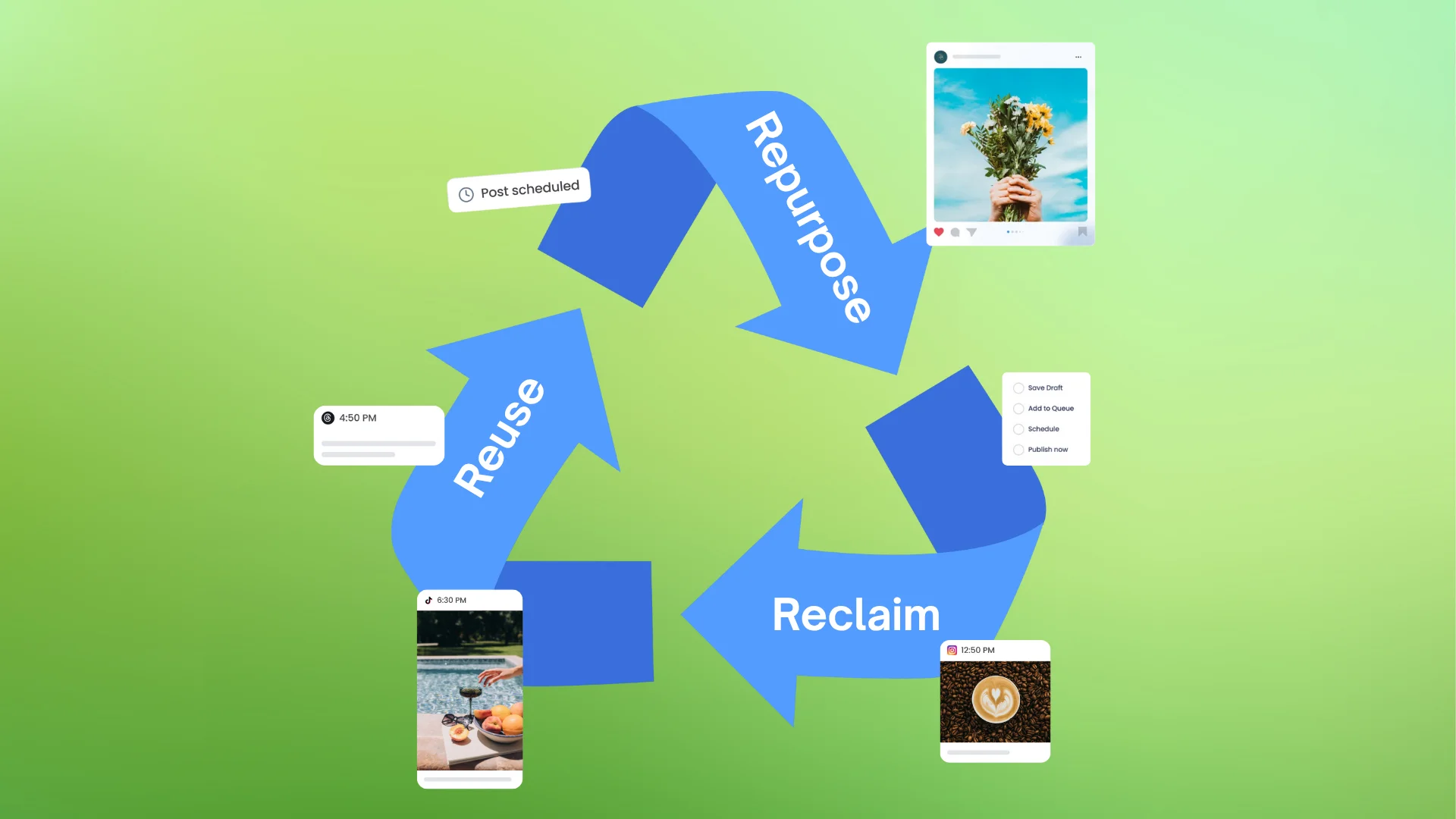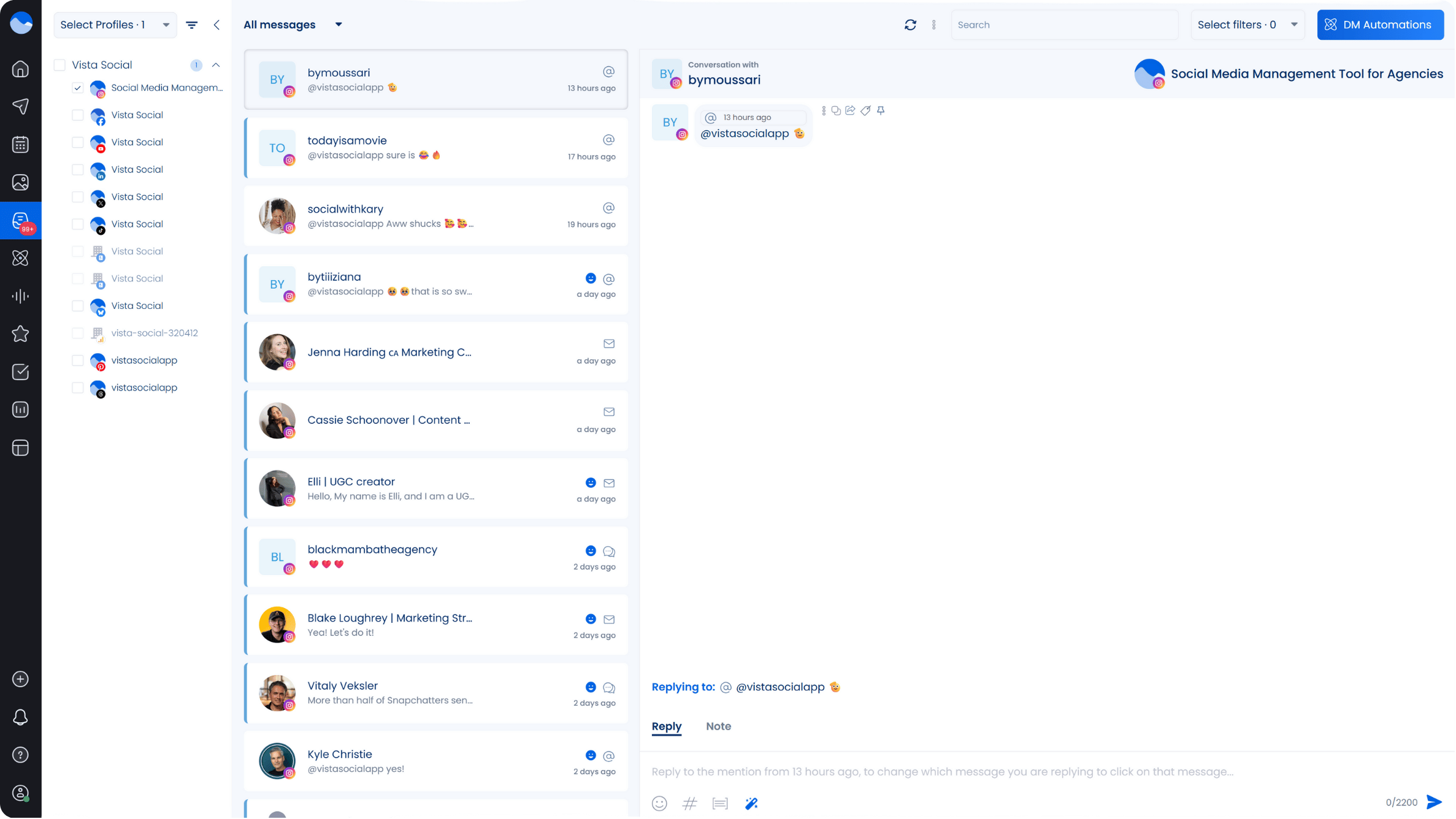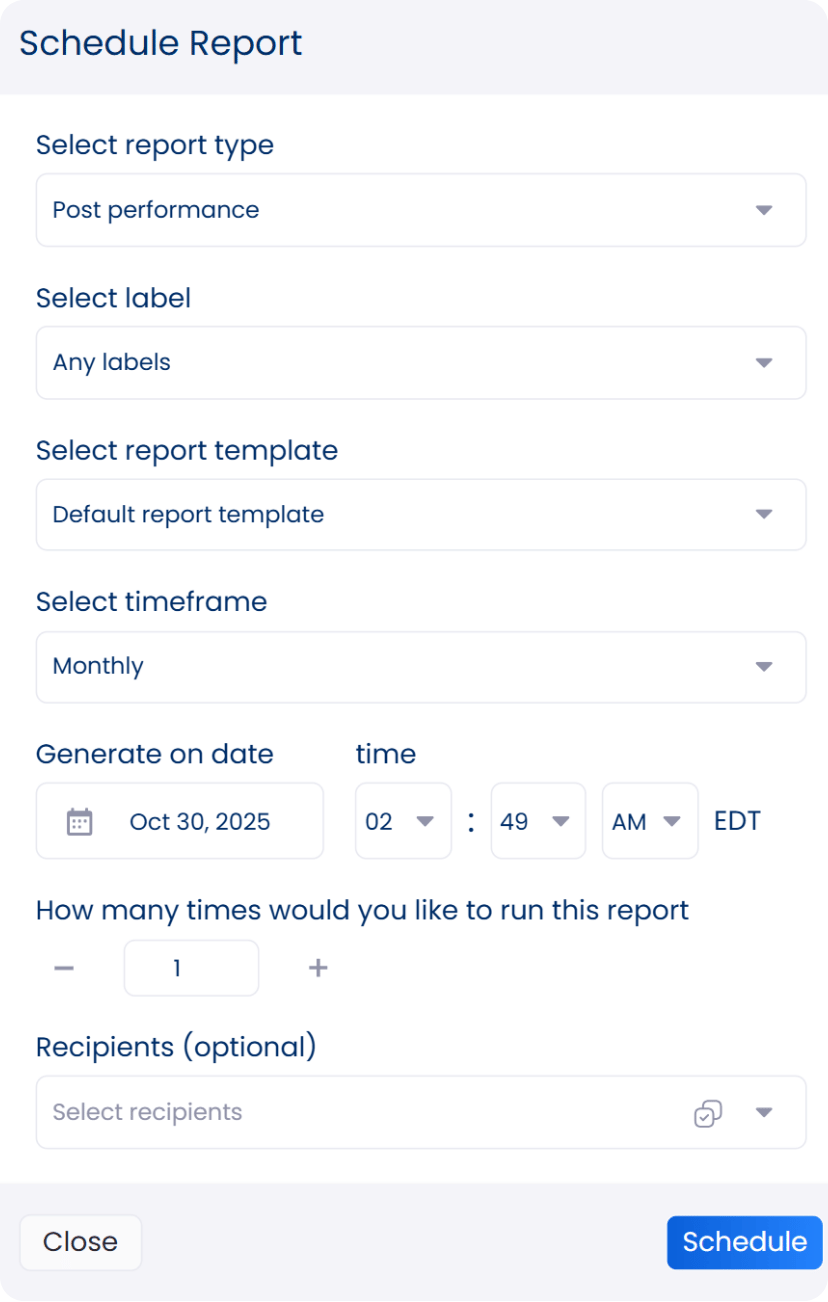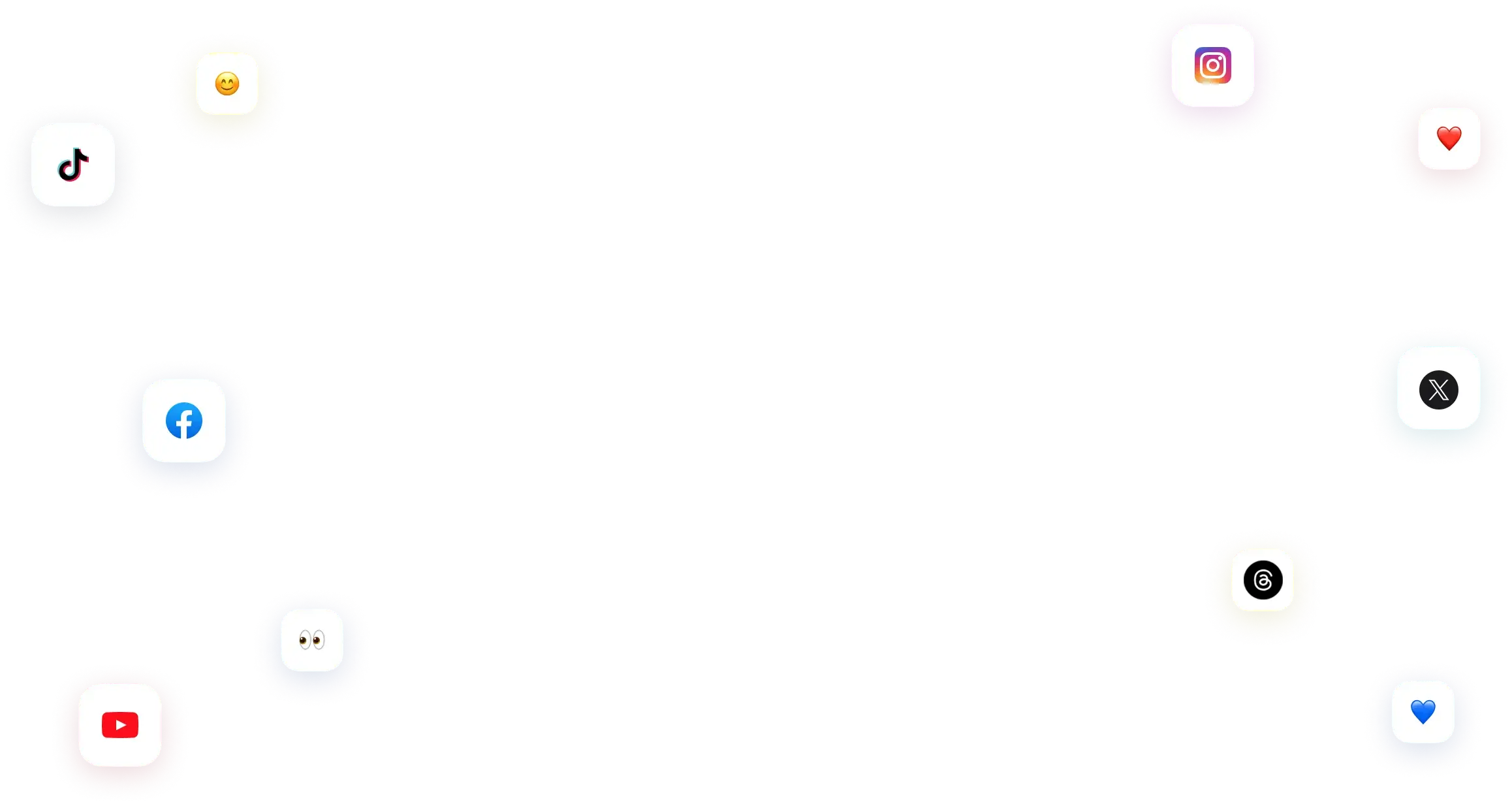New

Turn Your DMs Into Lead Gen!
Learn how to collect lead data from your DMs such as email addresses, phone numbers, and more right from your social inbox. If you are not yet automating your DMs your competitors are outpacing you.

How Something Social Saved 75% of Their Time and Increased Revenue by 15%
See how a fast-growing agency improved operations, cut down hours of manual work, and unlocked new revenue opportunities with Vista Social.
New

50 Unique Social Media Ideas for Consistent Content Creation
Discover 50 unique social media post ideas to engage your audience, grow your brand, and maintain a consistent content strategy with ease!

Mastering Content Reuse: The Key to a Consistent and Sustainable Posting Strategy
Published on September 20, 2024
13 min to read
Social Media Algorithm Guide for Agencies
Summarize with AI


Table of Content

Audiences often scroll past your clients’ posts without even knowing they exist. Non-followers miss the content simply because it never reaches their feed. One major reason is the social media algorithm. It picks what people see based on activity levels, plus how relevant a post looks at that moment.
You can’t control the algorithm, but you can shape how it reacts to your content. Smart choices influence what gets ranked higher, placed in feeds, or pushed toward new viewers.
This guide walks you through how an algorithm behaves so you can work with it instead of fighting it. You’ll pick up practical moves with useful tools that help your clients’ posts get better visibility, stronger traction, and more chances to be discovered.
Table of contents
What is a social media algorithm?
A social media algorithm is a set of signals and rules that automatically decides which content to show on a user’s feed. The algorithm ranks social media posts based on how likely users will interact with and like them. Social media algorithms surface posts that match users’ interests, creating a more personalized feed experience.
How does a social media algorithm work?
How social media algorithms work can vary for each platform. However, all the algorithms are based on Machine Learning (ML) and a set of factors known as ranking signals. The signals are used to rank each social media content’s value for each user at a specific time.
Although these algorithms rely on advanced AI, their purpose stays simple. They sort through social media posts and decide what each person sees in their feed. The signals they use are unique to every user because the system pays attention to how someone interacts with content on the platform. The goal is to keep people engaged by showing posts that hold their attention and encourage them to stay active on the app.
How does each social media algorithm on each platform work?
The truth is that social media platforms don’t reveal exactly how their algorithms work. However, many share helpful details about their ranking signals and how these systems generally operate. Knowing this helps you adjust your clients’ content and strategies so they align better with what each platform favors.
Understanding these signals gives you an edge because you can create content that feels natural to users while still aligning with what each platform’s system prefers to show. That said, below are the ranking signals known to influence major social media platforms.
The Facebook feed ranking signals include the following:
- Content type: Facebook prioritizes showing users more of the content formats they interact with most, such as videos or photos.
- Facebook connections: Feeds primarily show posts from Pages and people users follow and engage with regularly.
- AI-driven personalization: Meta’s 2025 Content Discovery Engine uses advanced AI to predict post relevance and dynamically rank content for each user.
- Likelihood of user engagement: The algorithm estimates how likely users are to like, comment, or share a post based on their past activity.
Instagram algorithms
Instagram uses multiple algorithms for its Feed, Stories, Reels plus Explore features. Let’s go over each algorithm’s ranking signals.
Instagram Stories algorithm
The algorithm for Instagram Stories sorts and prioritizes content posted by accounts a user follows, reflecting patterns seen in the Instagram following list order, where frequent engagement affects what users see first. With the algorithm set up this way, your clients won’t get new eyeballs in their Stories. However, you can still leverage how the algorithm works to help expand your clients’ organic reach.
The Instagram Story algorithm ranking signals include the following:
- Engagement history: The algorithm prioritizes showing Stories from users you’ve interacted with before.
- Viewing history: Frequently watching a user’s Stories boosts their placement on your list, while skipped Stories appear lower.
- Closeness: The algorithm favors Stories from people it identifies as your friends or family, showing them first.
Instagram feed algorithm
Instagram’s feed algorithm prioritizes content based on the following ranking signals.
- User activity: The algorithm looks at how you interact on the platform so it can shape your feed around the kinds of posts you tend to enjoy.
- Post information: Posts that quickly gain engagement or popularity are ranked higher in the feed.
- Poster information: The algorithm gauges your interest in an account based on past interactions.
- User history with the poster: You’ll see more content from people and accounts you follow, message, or engage with often.
Instagram Reels algorithm
According to Instagram, its Reels algorithm prioritizes entertaining and engaging content that keeps users watching until the end and encourages them to interact or share it. Instagram unified its Reels and Explore discovery systems, giving short-form videos broader visibility to non-followers. This means high-performing Reels can now surface in Explore results even faster, expanding organic reach beyond existing audiences.
The IG Reels algorithm’s ranking signals include the following.
- User activity: Shares, likes, comments, saves….you know the drill.
- User history with the poster: The algorithm considers the user’s previous interactions with the poster when “deciding” which content to show and display first.
- Reel information: This ranking signal factors in visual and audio track details, including the speed and level of engagement with the Reel.
- Poster information: The algorithm will consider the poster’s number of followers and level of engagement when ranking reels.
Instagram Explore algorithm
Instagram combined its Explore and Reels Discovery features to make short videos more visible to new audiences. This means your clients’ Reels now have a higher chance of showing up in discovery feeds, even for people who don’t follow them yet.
The Explore Page algorithm’s ranking signals include:
- User activity in Explore: The ranking signal is similar to the Feed algorithm’s, but this one focuses more on the content type.
- Post information: The Explore Page algorithm considers a user’s speed and level of interaction with a post when determining which content to feature first.
- Poster information: Similar to the Feed algorithm, the Explore algorithm looks for content from accounts with more followers and engagement.
Threads algorithm
Since Threads has grown steadily since its launch, the platform now uses a more refined algorithm that works closely with Instagram’s recommendation system. It pulls from trending discussions and user interests to suggest threads you’re most likely to join or respond to.
The platform’s known ranking signals include:
- User interactions: This refers to the number of times a user has liked the poster’s posts (thread) and how often the user viewed the poster’s profile on Instagram.
- Popularity: This is the number of times people have viewed or responded to a specific post (thread), and the number of times people have clicked on the account’s profile.
TikTok algorithm
TikTok’s algorithm works a little differently because it focuses on showing fresh content instead of just posts from creators people already follow.
The TikTok algorithm’s known ranking signals include the following:
- User behavior on Discover: This ranking signal looks at the overall qualities of the content so the system can understand what it’s about and decide how to place it.
- Previous interactions: The algorithm considers signals such as accounts the users have followed and hidden, including the content the user marked as not interesting or engaged with.
- Trends: TikTok’s algorithm tends to favor content that includes trending effects and sounds
- Location and language: TikTok now prioritizes localized content, giving creators and businesses more visibility among users who share their region or language.
TikTok also continues to strengthen localized visibility, ensuring that regional creators and brands appear more often on users’ For You Pages, especially when the content feels relevant to local culture or trends. Contrary to popular belief, TikTok’s algorithm doesn’t consider follower count a ranking signal.
One way to determine whether TikTok’s algorithm favors your client’s content is to check the percentage of users who saw the videos on the For You Pages (FYPS). A high number can mean that the algorithm is placing your clients’ videos in other users’ home feeds, drawing more eyeballs to the posts.
LinkedIn algorithm
LinkedIn’s algorithm isn’t designed to make any content go viral. The best way to get your clients to stand out is by creating high-quality content that genuinely connects with what their audiences care about most.
LinkedIn now focuses more on how long people stay to read and engage with a post. When your content sparks real conversations or teaches something valuable, it’s more likely to perform well. The algorithm now favors meaningful discussions over quick likes, so take time to create posts that make your audience think and respond.
The LinkedIn algorithm’s known ranking signals include the following:
- Content: LinkedIn analyzes the details of a post and how people engage with it to understand its value and decide how widely it should be shown.
- Identity: The algorithm considers how closely a user is related to a follower or someone in their extended network, including the user’s profile location.
- Member activity: The algorithm studies your behavior on the platform and uses those patterns to decide what shows up in your feed.
YouTube algorithm
Like TikTok, YouTube’s algorithm focuses more on showing users new content than videos from subscribed channels.
The platform’s known ranking signals are:
- User activity: YouTube’s algorithm suggests new videos based on the user’s previously watched content.
- Channel and topic watch duration: YouTube will show more content from channels that users frequently watch content from.
- Videos that are often watched together: YouTube’s algorithm factors in other user behaviors, such as other videos the user watches, to identify content they potentially like and will watch.
- Video performance: YouTube’s algorithm reviews how long people watch your videos and how they respond afterward to figure out what deserves more visibility.
- Viewer satisfaction and repeat viewership: The YouTube Shorts algorithm rewards creators whose videos keep viewers watching and returning for more.
X (Twitter) algorithm
The X (Previously Twitter) algorithm’s For You page ranking signals include the following:
- Content quality: X’s algorithm highlights content it sees as relevant and trustworthy while making sure it’s suitable for a wide audience.
- User connections: The algorithm can recommend content based on the topics and accounts the user already follows.
- Popularity: X’s algorithm ranks content based on how people in the user’s network interact with a post.
To get better visibility on X, focus on starting meaningful conversations and posting consistently around topics that matter to your audience. The algorithm rewards genuine engagement, so reply to comments often and join discussions that feel relevant to your clients’ community to help their posts appear more frequently on users’ For You pages.
Pinterest algorithm
Pinterest’s algorithm focuses more on search, which is slightly different from most social media platform algorithms. Essentially, the platform’s algorithm ranks content based on relevance and quality over frequency.
Try Vista Social for Free
A social media management platform that actually helps you grow with easy-to-use content planning, scheduling, engagement and analytics tools.
Get Started NowPinterest’s known ranking signals include the following.
- Metadata: Pinterest now uses advanced AI tagging and visual search to match product Pins with user intent, even when keywords don’t align.
- Active engagement: Pinterest’s algorithm looks for high signals of meaningful engagement, which often translates to saves.
What are the top tips to score points with the social media algorithm?
Winning the favor of social media algorithms takes the right strategies. Below are several best practices to help your clients get on the good side of social media algorithms.
1. Get to know social SEO
Wait a minute. What do social media algorithms have to do with social Search Engine Optimization (SEO)? A lot, actually, since social SEO helps boost the discoverability and visibility of your clients’ content, making them noticeable to algorithms. Using relevant keywords in your clients’ descriptions and profiles helps the algorithm understand the content and judge how well it fits what people want to see.
Use Vista Social to find relevant and popular hashtags in your industry, niche, or among your clients’ audiences. The social media management platform has an AI-powered hashtag generator that simplifies hashtag research and discovery.

2. Understand your target audience
What people find relevant often depends on who they are and what matters to them, which makes it important to understand your audience before creating content. That is why it’s crucial to understand your clients’ target audiences to tailor social media content that addresses their specific needs.
Relevant content that resonates with your clients’ followers can get the algorithm’s attention. It increases the chances of the algorithm putting your client’s content first in their audiences’ feeds.
3. Identify optimal posting times
Many social media algorithms consider early engagement and recent interactions critical ranking signals. That said, knowing when your clients’ target audiences will most likely be active and ready to engage on each social media platform is crucial.
Finding optimal posting times is easy with Vista Social’s social media publishing feature. After creating and customizing your client’s post in the Publisher, you can set your preferred auto-posting schedule or choose from the platform’s suggested optimal publishing times.

The platform studies how your clients’ audience behaves and uses those patterns to find the times when people are most active, helping their content get more genuine engagement. It’s no longer about posting whenever you feel like it. The right timing can greatly influence reach, so keep testing different hours and refine your schedule as you learn more about your audience.
4. Encourage interactions and engagement
Engagement is a crucial social media algorithm ranking signal, especially early engagement. An easy yet effective way to generate more engagement is to ask for it. No, I don’t mean begging followers to share or like your clients’ posts. Instead, create content that people can’t help but engage with.
For example, you can run fun activities like giveaways or challenges on different platforms to encourage engagement and inspire people to share your posts in a natural way, similar to a Social Media Interaction Post.
Another excellent engagement-boosting tactic is to engage with your clients’ followers. Jump into the comments section and answer questions or start conversations which can lead to more engagement.
Engagement works best when it feels genuine. If you take a moment to reply thoughtfully or add a bit of humor, people notice and naturally feel more connected. Simplify the way you handle your clients’ social interactions with Vista Social’s social media engagement feature. It includes a unified Social Inbox where you can manage all client interactions from one place.

This way, you won’t miss any engagement opportunities and respond to inquiries promptly. It helps your clients provide seamless user experiences to followers and customers.
Use the AI Assistant to generate relevant and engaging replies quickly. You can also use the AI Assistant in Vista Social’s Publisher to generate and refine post descriptions and taglines to make your clients’ posts more engaging.
Remember, social media algorithms favor content and accounts with high engagement rates, so engage your clients’ audiences wherever and however you can.
5. Experiment and get creative
The reality is that making social media algorithms work for your clients is a science and an art. Plus, social media platforms constantly update their algorithms, so what may work for your clients now may not work as well in the future.
Your best approach is to keep up with how social media algorithms evolve and adjust your clients’ strategies whenever new ranking signals or trends emerge. Also, experiment with your clients’ posts and tactics to see what works best for their audiences and the algorithms.
Key metrics like engagement and reach can give you a clearer idea of what content formats resonate most. Use Vista Social’s social media analytics feature to monitor performance and refine your clients’ strategy based on real data.

The platform also lets you create custom reports and set schedules to auto-generate and share the reports with clients and other stakeholders.

Mix different elements of your clients’ content to create posts that draw people in and signal to the algorithm that the material is worth showing.
6. Share more videos
Many social media algorithms embrace videos, especially short-form videos since these tend to get the highest engagement rates.
Think of viral TikTok videos. To capture the attention of social media algorithms, create more videos that align with your clients’ social media strategies and the platforms on which they are published. You can help boost your clients’ engagement by creating and sharing more TikTok videos, Instagram Reels, YouTube Shorts, Facebook feed videos, etc.
However, don’t neglect other visual social media content, especially if it draws crowds. Include visually compelling content like carousels, animations, slideshows, GIFs, infographics plus additional formats.
7. Jump into trends
Trending posts and topics keep users engaged and scrolling for more, making them the go-to content for social media algorithms to feature. Help your clients join the fun by creating content incorporating trending topics or activities into their social media posts.
It can be anything, from a fun TikTok dance challenge to popular sounds or audio clips. However, avoid jumping into every trend you see in the name of popularity. Be selective and add only the trends that fit your clients’ brands so everything stays aligned with their overall identity and social media guidelines.
The best place to start is to listen to what your clients’ followers are saying on social media through social listening. Use Vista Social’s social media listening feature to set up Listeners. The Listeners can track and pull conversations around your specified keywords or topics across your clients’ connected profiles.

Social listening helps you understand what’s buzzing, including audience sentiment. This allows you to find trends to incorporate into your clients’ content strategies and score points with the algorithms.
Ready to make the social media algorithm work for your clients?
There is no one-size-fits-all formula to winning over social media algorithms. However, you can boost the chances of the algorithms favoring your clients’ content by understanding how they work and knowing the effective strategies to make the algorithms work for them.
Use the right social media management tool to help put your clients in good standing with social media algorithms. If you’re ready to make social algorithms work for your clients, now’s the best time to take action
What are the social media algorithm FAQs?
Check out the commonly asked questions about social media algorithms below.
Which platforms have the best social media algorithms?
YouTube, Instagram and Facebook are considered to have the strongest social media algorithms. The platforms leverage advanced algorithms to surface and personalize relevant content for users. They also use these algorithms to stop the spread of hate speech and misinformation.
What is one disadvantage of social media algorithms?
One downside to social media algorithms is their tendency to be biased, such as featuring specific types of content over others or highlighting one voice while silencing others. It can reinforce existing biases and inequalities in society, shaping how social media users think and behave both online and offline.
How do social media algorithms impact businesses?
Social media algorithms can strongly influence your clients’ marketing strategies. Since the algorithms control what people see in their feeds, they play a major role in how well your clients’ brands connect with their audiences and how their content performs across each platform.
When you understand how each algorithm works, you can plan smarter and reach a wider audience while building genuine relationships through outsourcing social media marketing. As social media algorithms continue to evolve, agencies that adapt quickly will always have the upper hand. Rather than trying to beat the system, focus on understanding how it moves and adjusting along the way.
Keep a close eye on performance trends and make gradual improvements to your content strategy. This steady approach helps your clients stay visible and relevant, even as platforms keep changing.
About the Author
Content Writer
Jimmy Rodela is a social media and content marketing consultant with over 9 years of experience, with work appearing on sites such as Business.com, Yahoo, SEMRush, and SearchEnginePeople. He specializes in social media, content marketing, SaaS, small business strategy, marketing automation, and content development.
Read with AI
Save time reading this article using your favorite AI tool
Summarize with AI
Never Miss a Trend
Our newsletter is packed with the hottest posts and latest news in social media.

You have many things to do.
Let us help you with social media.
Use our free plan to build momentum for your social media presence.
Or skip ahead and try our paid plan to scale your social media efforts.
P.S. It will be a piece of cake 🍰 with Vista Social
Subscribe to our Newsletter!
To stay updated on the latest and greatest Social Media news. We promise not to spam you!


